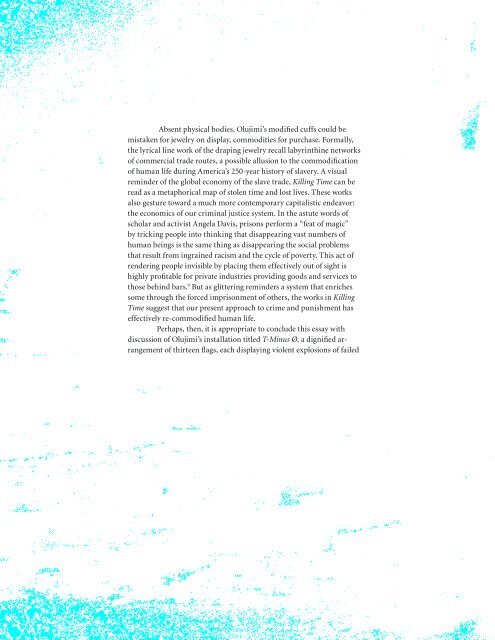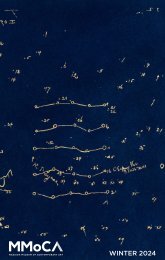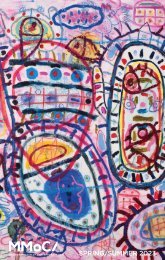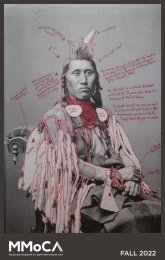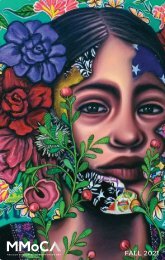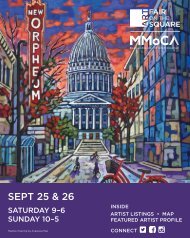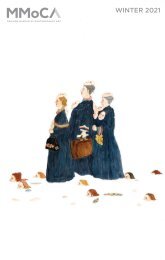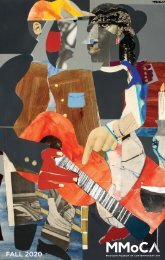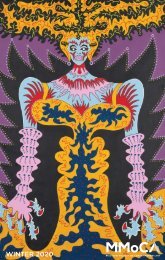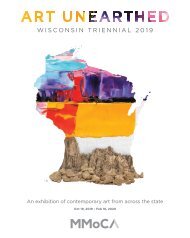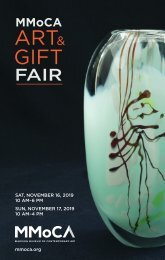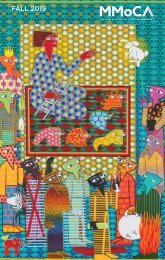Kambui Olujimi: Zulu Time exhibition catalog
This catalog is from the installation of this exhibition at MMoCA. It includes essays by Sampada Aranke, Leah Kolb, and Gregory Volk.
This catalog is from the installation of this exhibition at MMoCA. It includes essays by Sampada Aranke, Leah Kolb, and Gregory Volk.
You also want an ePaper? Increase the reach of your titles
YUMPU automatically turns print PDFs into web optimized ePapers that Google loves.
Absent physical bodies, <strong>Olujimi</strong>’s modified cuffs could be<br />
mistaken for jewelry on display, commodities for purchase. Formally,<br />
the lyrical line work of the draping jewelry recall labyrinthine networks<br />
of commercial trade routes, a possible allusion to the commodification<br />
of human life during America’s 250-year history of slavery. A visual<br />
reminder of the global economy of the slave trade, Killing <strong>Time</strong> can be<br />
read as a metaphorical map of stolen time and lost lives. These works<br />
also gesture toward a much more contemporary capitalistic endeavor:<br />
the economics of our criminal justice system. In the astute words of<br />
scholar and activist Angela Davis, prisons perform a “feat of magic”<br />
by tricking people into thinking that disappearing vast numbers of<br />
human beings is the same thing as disappearing the social problems<br />
that result from ingrained racism and the cycle of poverty. This act of<br />
rendering people invisible by placing them effectively out of sight is<br />
highly profitable for private industries providing goods and services to<br />
those behind bars. 9 But as glittering reminders a system that enriches<br />
some through the forced imprisonment of others, the works in Killing<br />
<strong>Time</strong> suggest that our present approach to crime and punishment has<br />
effectively re-commodified human life.<br />
Perhaps, then, it is appropriate to conclude this essay with<br />
discussion of <strong>Olujimi</strong>’s installation titled T-Minus Ø, a dignified arrangement<br />
of thirteen flags, each displaying violent explosions of failed<br />
rocket launches. Whether or not <strong>Olujimi</strong>’s objective was to circle back to<br />
the legacies of Western colonialism by alluding to the original thirteen<br />
British colonies in North America, the flags nevertheless vibrate with<br />
nationalist intention. In the United States, we make public affirmations<br />
of loyalty to our flag, which we see as a symbol of our country, our history,<br />
and our pride in both. But if a flag represents such an idea, or even<br />
an ideal, what exactly are we are being asked to salute? The veiled legacy<br />
of a dehumanizing economy? <strong>Olujimi</strong>’s flags, with their grand imagery<br />
of collapse, point to the failures in our nationalist agenda, both past and<br />
present, visible and invisible. With T-Minus Ø, <strong>Olujimi</strong> suggests that we<br />
are, indeed, out of time; that we have entered a moment in time when we<br />
must face those failures, acknowledge the subtleties of institutionalized<br />
biases, and make visible those bodies that are being kept out of sight<br />
through underhanded strategies of subjugation.<br />
8. Garrick L. Percival cites numerous studies<br />
showing Blacks are 6 to 8 times more likely<br />
to be incarcerated relative to whites, and<br />
Hispanics are 3 ½ times more likely to be<br />
incarcerated than whites. Garrick L. Percival,<br />
“Ideology, Diversity, and Imprisonment:<br />
Considering the Influence of Local Politics<br />
on Racial and Ethnic Minority Incarceration<br />
Rates,” Social Science Quarterly 91, no.4<br />
(2010): 1064-1082. See, also, Leah Sakala,<br />
“Breaking Down Mass Incarceration rates in<br />
the 2010 Census,” https://www.prisonpolicy.<br />
org/reports/rates.html.<br />
9. Angela Davis, “Masked Racism: Reflections<br />
on the Prison Industrial Complex,” in Race,<br />
Class, and Gender in the United States (7th<br />
edition), ed. Paula S. Rothenberg (New York:<br />
Worth Publishers, Inc., 2007), 683-87.<br />
16, 21:<br />
Ville Radieuse, habiteà-machine<br />
(The Radiant<br />
City, the living machine)<br />
(installation detail)<br />
22–23:<br />
The Black That Birthed Us<br />
(installation detail)<br />
24 25


